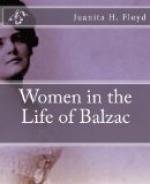For some time Balzac had been looking for a home worthy of his fiancee and had finally decided on the Villa Beaujon, in the rue Fortunee. Since this home was created “for her and by her,” it was necessary for her to be consulted in the reconstruction and decoration of it, so he brought her secretly to Paris, and her daughter and son-in-law returned to Wierzchownia. This was not only a long separation for so devoted a mother and daughter, but there was some danger lest her incognito be discovered; Balzac, accordingly, took every precaution. It is easy to picture the extreme happiness of the novelist in conducting his Louloup over Paris, in having her near him while he was writing some of his greatest masterpieces, and, naturally, hoping that the everlasting debts would soon be defrayed and the marriage ceremony performed, but fortunately, he was not permitted to know beforehand of the long wait and the many obstacles that stood in his way.
Just what happened during the spring and summer of 1847 is uncertain, as few letters of this period exist in print. Miss Sandars (Balzac), states that about the middle of April Balzac conducted Madame Hanska to Forbach on her return to Wierzchownia, and when he returned to Paris he found that some of her letters to him had been stolen, 30,000 francs being demanded for them at once, otherwise the letters to be turned over to the Czar. Miss Sandars states also that this trouble hastened the progress of his heart disease, and that when the letters were eventually secured (without the payment) Balzac burned them, lest such a catastrophe should occur again. The Princess Radziwill says that the story of the letters was invented by Balzac and is ridiculous; also, that it angered her aunt because Balzac revealed his ignorance of Russian matters, by saying such things. Lawton (Balzac) intimates that Balzac and Madame Hanska quarreled, she being jealous and suspicious of his fidelity, and that he burned her letters. De Lovenjoul (Un Roman d’Amour) makes the same statement and adds that this trouble increased his heart disease. But he says also (La Genese d’un Roman de Balzac) that Madame Hanska spent two months secretly in Paris in April and May; yet, a letter written by Balzac, dated February 27, 1847, shows that she was in Paris at that time.
Balzac went to Wierzchownia in September, 1847, and traveled so expeditiously that he arrived there several days before his letter which told of his departure. When one remembers how he had planned with M. de Hanski more than ten years before to be his guest in this chateau, one can imagine his great delight now in journeying thither with the hope of accomplishing the great desire of his life. He was royally entertained at the chateau and was given a beautiful little suite of rooms composed of a salon, a sitting-room, and a bed-room.[*]
[*] This house, where all the mementos of Balzac,
including his
portrait, were preserved intact
by the family, has been utterly
destroyed by the Bolsheviks.




